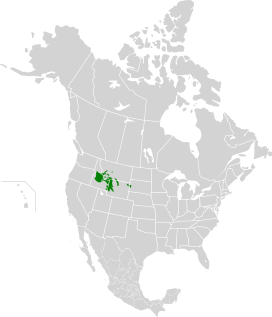South Central Rockies forests facts for kids
Quick facts for kids South Central Rockies forests |
|
|---|---|

Subalpine forest in Shoshone National Forest, Wyoming
|
|
 |
|
| Ecology | |
| Realm | Nearctic |
| Biome | Temperate coniferous forest |
| Borders |
List
|
| Bird species | 201 |
| Mammal species | 99 |
| Geography | |
| Country | United States |
| States | Montana, Idaho, Wyoming and South Dakota |
| Conservation | |
| Habitat loss | 1.6644% |
| Protected | 82.66% |
The South Central Rockies forests is a special natural area. It is a type of forest called a temperate coniferous forest. This means it has lots of cone-bearing trees like pines and spruces. This ecoregion is mostly found in the United States. You can find it mainly in the states of Wyoming, Idaho, and Montana. This area is much drier than the North Central Rockies forests.
Contents
Where Are the South Central Rockies Forests?
This amazing forest area is mostly in western Wyoming. But it also stretches into eastern and central Idaho. You can find parts of it in southwestern and south-central Montana. It even reaches into northeastern Wyoming and southwestern South Dakota.
The heart of this ecoregion is the Yellowstone Plateau. From there, it spreads out to connected mountain ranges. It also includes some mountains that stand alone. These include the Bighorn Mountains and the Black Hills. There are also smaller, isolated mountains in central Montana. The weather here is dry. Summers are short, and winters are long and very cold.
Plants of the South Central Rockies
This ecoregion is mostly covered in coniferous forest. This means it has many trees that stay green all year. The most common tree is the lodgepole pine. There are so many lodgepole pines because of big fires that happened in the past.
Other trees you might see include Engelmann spruce and Rocky Mountain Douglas-fir. You can also find subalpine fir and trembling aspen. At higher elevations, near the tree line, you'll see whitebark pine. This tree is very important for the ecosystem.
Besides forests, this ecoregion has other cool habitats. There are mountain meadows with tall grasses and wildflowers. You'll find grasslands in the foothills. Along rivers, there are special woodlands. High up in the mountains, there's alpine tundra. This is a cold, treeless area. In some spots, hot springs and geysers create warm areas. These unique places have plants that can only grow there.
Animals of the South Central Rockies
This ecoregion is home to many different animals. It's a great place for wildlife!
Mammals Living in the Forests
Many large mammals live here. You might spot elk and mule deer. There are also bighorn sheep climbing the rocky slopes. Large plains bison roam in some areas. You could also see Shiras moose.
Predators like the cougar are found here. The powerful grizzly bear and northwestern wolf also call this place home. Other bears include the black bear. Smaller predators like the bobcat and Canada lynx hunt in these forests. The clever coyote is also common. You might see North American beaver building dams in rivers. The playful North American river otter swims in the waters. And the snowshoe hare hops through the snow.
Birds of the Rocky Mountains
This ecoregion has many birds. They are typical of the northern Rocky Mountains. Common birds include the Steller's jay, black-capped chickadee, and pine siskin.
Some special birds live here too. These include the white pelican and the large trumpeter swan. The (black) rosy finch is another unique bird. Other birds you might see are the harlequin duck and Barrow's goldeneye. Look up for birds of prey like Swainson's hawk, bald eagle, and osprey. Ground birds like the sage grouse and sandhill crane are also present. You might spot a Franklin's gull near water. Smaller birds include the American dipper, Townsend's solitaire, yellow-rumped warbler, and Brewer's sparrow.
Reptiles and Amphibians
The cold-blooded animals here are also interesting. You might find the spotted frog. Snakes include the prairie rattlesnake and the harmless rubber boa. The boreal toad and blotched tiger salamander are also part of this ecoregion's wildlife.
Protecting the South Central Rockies Forests
Even though many parts of this ecoregion are protected, it's still considered "vulnerable." This means it needs our help to stay healthy.
One big threat is logging in areas that are not protected. Another concern is the safety of grizzly bears and wolves. Sometimes, hunters who are looking for other animals might accidentally harm these important predators.
Luckily, there are many protected areas. These include famous places like Yellowstone National Park. Yellowstone is in northwestern Wyoming, south-central Montana, and eastern Idaho. Grand Teton National Park in western Wyoming also protects part of this ecoregion. Other protected spots are Cloud Peak Wilderness in north-central Wyoming and Black Elk Wilderness in southwestern South Dakota. These protected lands help keep the South Central Rockies forests safe for future generations.

